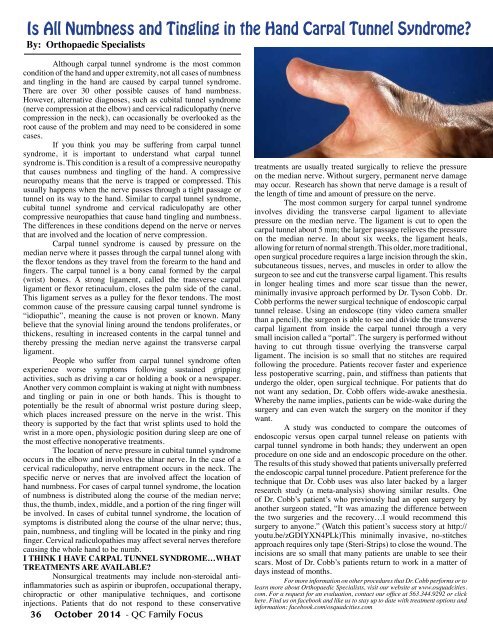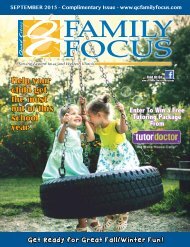QC Family Focus: October 2014
In this issue: A Look at the Very Real Dangers Facing Teens and Tweens Scarecrow Shenanigans Choosing the Perfect Daycare Helping Your Child Prepare for Kindergarten Treats and Snacking can Lead to Tooth Decay Learn more about QC Family Focus Magazine at our website: www.qcfamilyfocus.com Like us on Facebook: www.facebook.com/qcfamilyfocus
In this issue:
A Look at the Very Real Dangers Facing Teens and Tweens
Scarecrow Shenanigans
Choosing the Perfect Daycare
Helping Your Child Prepare for Kindergarten
Treats and Snacking can Lead to Tooth Decay
Learn more about QC Family Focus Magazine at our website: www.qcfamilyfocus.com
Like us on Facebook: www.facebook.com/qcfamilyfocus
You also want an ePaper? Increase the reach of your titles
YUMPU automatically turns print PDFs into web optimized ePapers that Google loves.
Is All Numbness and Tingling in the Hand Carpal Tunnel Syndrome?<br />
By: Orthopaedic Specialists<br />
Although carpal tunnel syndrome is the most common<br />
condition of the hand and upper extremity, not all cases of numbness<br />
and tingling in the hand are caused by carpal tunnel syndrome.<br />
There are over 30 other possible causes of hand numbness.<br />
However, alternative diagnoses, such as cubital tunnel syndrome<br />
(nerve compression at the elbow) and cervical radiculopathy (nerve<br />
compression in the neck), can occasionally be overlooked as the<br />
root cause of the problem and may need to be considered in some<br />
cases.<br />
If you think you may be suffering from carpal tunnel<br />
syndrome, it is important to understand what carpal tunnel<br />
syndrome is. This condition is a result of a compressive neuropathy<br />
that causes numbness and tingling of the hand. A compressive<br />
neuropathy means that the nerve is trapped or compressed. This<br />
usually happens when the nerve passes through a tight passage or<br />
tunnel on its way to the hand. Similar to carpal tunnel syndrome,<br />
cubital tunnel syndrome and cervical radiculopathy are other<br />
compressive neuropathies that cause hand tingling and numbness.<br />
The differences in these conditions depend on the nerve or nerves<br />
that are involved and the location of nerve compression.<br />
Carpal tunnel syndrome is caused by pressure on the<br />
median nerve where it passes through the carpal tunnel along with<br />
the flexor tendons as they travel from the forearm to the hand and<br />
fingers. The carpal tunnel is a bony canal formed by the carpal<br />
(wrist) bones. A strong ligament, called the transverse carpal<br />
ligament or flexor retinaculum, closes the palm side of the canal.<br />
This ligament serves as a pulley for the flexor tendons. The most<br />
common cause of the pressure causing carpal tunnel syndrome is<br />
“idiopathic”, meaning the cause is not proven or known. Many<br />
believe that the synovial lining around the tendons proliferates, or<br />
thickens, resulting in increased contents in the carpal tunnel and<br />
thereby pressing the median nerve against the transverse carpal<br />
ligament.<br />
People who suffer from carpal tunnel syndrome often<br />
experience worse symptoms following sustained gripping<br />
activities, such as driving a car or holding a book or a newspaper.<br />
Another very common complaint is waking at night with numbness<br />
and tingling or pain in one or both hands. This is thought to<br />
potentially be the result of abnormal wrist posture during sleep,<br />
which places increased pressure on the nerve in the wrist. This<br />
theory is supported by the fact that wrist splints used to hold the<br />
wrist in a more open, physiologic position during sleep are one of<br />
the most effective nonoperative treatments.<br />
The location of nerve pressure in cubital tunnel syndrome<br />
occurs in the elbow and involves the ulnar nerve. In the case of a<br />
cervical radiculopathy, nerve entrapment occurs in the neck. The<br />
specific nerve or nerves that are involved affect the location of<br />
hand numbness. For cases of carpal tunnel syndrome, the location<br />
of numbness is distributed along the course of the median nerve;<br />
thus, the thumb, index, middle, and a portion of the ring finger will<br />
be involved. In cases of cubital tunnel syndrome, the location of<br />
symptoms is distributed along the course of the ulnar nerve; thus,<br />
pain, numbness, and tingling will be located in the pinky and ring<br />
finger. Cervical radiculopathies may affect several nerves therefore<br />
causing the whole hand to be numb.<br />
I THINK I HAVE CARPAL TUNNEL SYNDROME…WHAT<br />
TREATMENTS ARE AVAILABLE?<br />
Nonsurgical treatments may include non-steroidal antiinflammatories<br />
such as aspirin or ibuprofen, occupational therapy,<br />
chiropractic or other manipulative techniques, and cortisone<br />
injections. Patients that do not respond to these conservative<br />
36 <strong>October</strong> <strong>2014</strong> - <strong>QC</strong> <strong>Family</strong> <strong>Focus</strong><br />
treatments are usually treated surgically to relieve the pressure<br />
on the median nerve. Without surgery, permanent nerve damage<br />
may occur. Research has shown that nerve damage is a result of<br />
the length of time and amount of pressure on the nerve.<br />
The most common surgery for carpal tunnel syndrome<br />
involves dividing the transverse carpal ligament to alleviate<br />
pressure on the median nerve. The ligament is cut to open the<br />
carpal tunnel about 5 mm; the larger passage relieves the pressure<br />
on the median nerve. In about six weeks, the ligament heals,<br />
allowing for return of normal strength. This older, more traditional,<br />
open surgical procedure requires a large incision through the skin,<br />
subcutaneous tissues, nerves, and muscles in order to allow the<br />
surgeon to see and cut the transverse carpal ligament. This results<br />
in longer healing times and more scar tissue than the newer,<br />
minimally invasive approach performed by Dr. Tyson Cobb. Dr.<br />
Cobb performs the newer surgical technique of endoscopic carpal<br />
tunnel release. Using an endoscope (tiny video camera smaller<br />
than a pencil), the surgeon is able to see and divide the transverse<br />
carpal ligament from inside the carpal tunnel through a very<br />
small incision called a “portal”. The surgery is performed without<br />
having to cut through tissue overlying the transverse carpal<br />
ligament. The incision is so small that no stitches are required<br />
following the procedure. Patients recover faster and experience<br />
less postoperative scarring, pain, and stiffness than patients that<br />
undergo the older, open surgical technique. For patients that do<br />
not want any sedation, Dr. Cobb offers wide-awake anesthesia.<br />
Whereby the name implies, patients can be wide-wake during the<br />
surgery and can even watch the surgery on the monitor if they<br />
want.<br />
A study was conducted to compare the outcomes of<br />
endoscopic versus open carpal tunnel release on patients with<br />
carpal tunnel syndrome in both hands; they underwent an open<br />
procedure on one side and an endoscopic procedure on the other.<br />
The results of this study showed that patients universally preferred<br />
the endoscopic carpal tunnel procedure. Patient preference for the<br />
technique that Dr. Cobb uses was also later backed by a larger<br />
research study (a meta-analysis) showing similar results. One<br />
of Dr. Cobb’s patient’s who previously had an open surgery by<br />
another surgeon stated, “It was amazing the difference between<br />
the two surgeries and the recovery…I would recommend this<br />
surgery to anyone.” (Watch this patient’s success story at http://<br />
youtu.be/zGDIYXN4PLk)This minimally invasive, no-stitches<br />
approach requires only tape (Steri-Strips) to close the wound. The<br />
incisions are so small that many patients are unable to see their<br />
scars. Most of Dr. Cobb’s patients return to work in a matter of<br />
days instead of months.<br />
For more information on other procedures that Dr. Cobb performs or to<br />
learn more about Orthopaedic Specialists, visit our website at www.osquadcities.<br />
com. For a request for an evaluation, contact our office at 563.344.9292 or click<br />
here. Find us on facebook and like us to stay up to date with treatment options and<br />
information: facebook.com/osquadcities.com

















